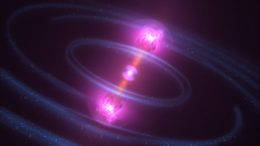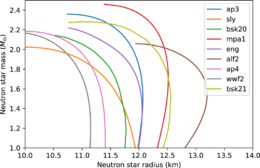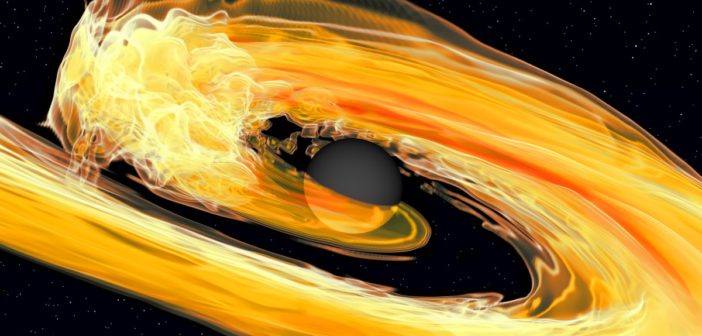Heavy metals are thought to form in space in only a few specific ways. Which scenario makes more of these elements: two neutron stars colliding or a neutron star merging with a black hole?
A Universal Supply of Metals

This digital illustration depicts the aftermath of a collision between two neutron stars. [NASA’s Goddard Space Flight Center/CI Lab]
The possible origins of r-process elements are limited, since they form in hot, extremely dense environments. Core-collapse supernovae and collapsars are contenders, but lately astronomers have considered collisions between neutron stars or neutron star–black hole pairs as potential sources of heavy elements. But which of these two types of collisions makes the most heavy metals?

The authors used multiple different neutron star equations of state in their models. Of the nine models used, wwf2 is the most compact or “stiffest.” These equations of state are based on observations of pulsars. [Chen, Vitale & Foucart 2021]
Computing Collisions
A team led by Hsin-Yu Chen (Massachusetts Institute of Technology) addressed this open question by estimating how much each type of merger contributes to the universal supply of r-process elements. In order to make this estimate, the team drew upon gravitational-wave observations and existing models to calculate how much metal a single merger creates and how frequently these mergers occur.
Chen and coauthors explored six different models with different spin and mass distributions for the black holes and neutron stars, as well as various neutron star equations of state — a description of how loose or compacted the neutron star is — all of which affect how much r-process material forms in the collision. For each set of model parameters, they simulated the collisions of 100,000 neutron star and neutron star–black hole pairs.
An Array of Possibilities

The neutron star equation of state affects the amount of material ejected during the collision. “Stiffer” equations of state (labeled ap4 and wwf2) result in the most material ejected. [Chen, Vitale & Foucart 2021]
Astronomers should be able to refine these estimates in the future. Pulsar observations should help us gain a better understanding of the compactness of neutron stars, and as we detect more gravitational waves from collisions between compact objects, we can make better estimates of the frequency of these collisions. Chen and coauthors also point out that our current gravitational-wave observations mainly probe the past 2.5 billion years, but future detectors will allow us to peer back into the distant past to understand how metals formed long ago.
Citation
“The Relative Contribution to Heavy Metals Production from Binary Neutron Star Mergers and Neutron Star–Black Hole Mergers,” Hsin-Yu Chen, Salvatore Vitale, and Francois Foucart 2021 ApJL 920 L3. doi:10.3847/2041-8213/ac26c6
